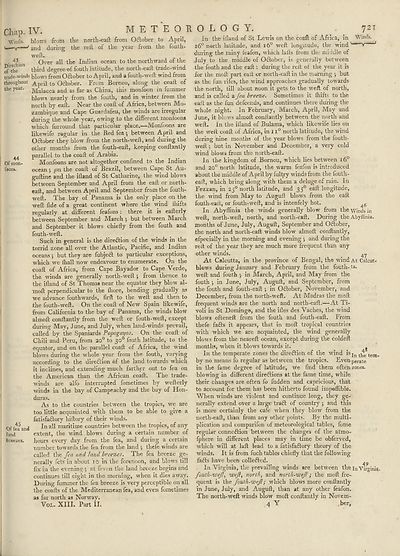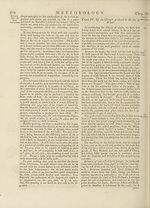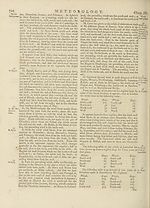Encyclopaedia Britannica, or, a Dictionary of arts, sciences, and miscellaneous literature : enlarged and improved. Illustrated with nearly six hundred engravings > Volume 13, MAT-MIC
(767) Page 721
Download files
Complete book:
Individual page:
Thumbnail gallery: Grid view | List view

the
the
METEOR
north-eaft from October to April,
reft of the year
from the fouth-
Indian ocean to the northward of the
44
Of mon-
faons.
Chap. IV.
Winds, blows from
—V““'' and during
weft.
TV edt’on Over all the
third degree of fouth latitude, the north-eaft trade-wind
trade-wind' blows from Oftober to April, and a fouth-weft wind from
throughout to October. From Borneo, along the coaft of
the year. Malacca an^ as far as China, this monfoon in fummer
blows nearly from the louth, and in winter from the
north by eaft. Near the coaft of Africa, between Mo¬
zambique and Cape Guardafeu, the winds are irregular
during the whole year, owing to the different monioons
which furround that particular place.—Monfoons are
likewife regular in the Red fea} between April and
October they blow from the north-weft, and during the
other months from the fouth-eaft, keeping conftantly
parallel to the coaft of Arabia.
Monfoons are not altogether confined to the Indian
ocean j pn the coaft of Brazil, between Cape St Au-
guftine and the ifland of St Catharine, the wind blows
between September and April from the eaft or north-
eaft, and between April and September from the fouth-
weft:. The bay of Panama is the only place on the
weft fide of a great continent where the wind Ihifts
regularly at different feafons: there it is eafterly
between September and March ; but between March
and September it blows chiefly from the fouth and
fouth-weft.
Such in general is the dire&ion of the winds in the
torrid zone all over the Atlantic, Pacific, and Indian
oceans j but they are fubjeft to particular exceptions,
which we fliall now endeavour to enumerate. On the
coaft of Africa, from Cape Bayador to Cape Verde,
the winds are generally north-weft j from thence to
the ifland of St Thomas near the equator they blow al-
moft perpendicular to the fliore, bending gradually as
we advance fouthwards, firft to the weft and then to
the fouth-weft. On the coaft of Ncav Spain likewife,
from California to the bay of Panama, the winds blow
almoft conftantly from the weft or fouth-weft, except
during May, June, and July, when land-Avinds prevail,
called by the Spaniards Popogayos. On the coaft of
Chili and Peru, from 20° to 30° fouth latitude, to the
equator, and on the parallel coaft of Africa, the wind
blows during the whole year from the fouth, varying
according to the direftion of the land towards which
it inclines, and extending much farther out to fea on
the American than the African coaft. The trade-
winds are alfo interrupted fometimes by wefterly
winds in the bay of Campeachy and the bay of Hon¬
duras.
As to the countries between the tropics, we are
too little acquainted with them to be able to give a
fatisfaftory hiftory of their winds.
In all maritime countries betsveen the tropics, of any
extent, the wind blows during a certain number of
hours every day from the fea, and during a certain
number towards the fea from the land •, thefe winds are
called the fea and land breezes. The fea breeze ge¬
nerally fets in about 10 in the forenoon, and blows till
fix in the evening •, at feven the land breeze begins and
continues till eight in the morning, when it dies away.
During fummer the fea breeze is very perceptible on all
the coafts of the Mediterranean fea, and even fometimes
as far north as Norway.
Vol. XIII. Part II.
„ 45 ,
Of fea and
land
fcreezes.
46
O L O G Y.
In the ifland of St Lewis on the coaft of Africa, in
16° north latitude, and 160 weft longitude, the wind
during the rainy leafon, which lalls from the middle of
July to the middle of October, is generally between
the fouth and the eaft : during the reft of the year it is
for the moft part eult or north-caft in the morning j but
as the fun rifes, the wind approaches gradually towards
the north, till about noon it gets to the weft of north,
and is called a fea breeze. Sometimes it fluffs to the
eait as the fun defcends, and continues there during the
whole night. In February, March, April, May and
June, it blows almoft conftantly between the north and
weft. In the iliand of Bulama, which likewife lies 011
the weft coaft of Africa, in ll° north latitude, the wind
during nine months of the year blows from the fouth-
weft ; but in November and December, a very cold
wind blows from the north-eaft.
In the kingdom of Bornou, which lies between 160
and 20° north latitude, the warm feafon is introduced
about the middle of April by fultry winds from the fouth-
eaft, which bring along with them a deluge of rain. In
Fezzan, in 250 north latitude, and 350 eaft longitude,
the wind from May to Auguft blows from the eaft
fouth-eaft, or fouth-weft, and is intenfely hot.
In Abyffinia the winds generally blow from the winds in
weft, north-weft, north, and north-eaft. During the Abyffinia.
months of June, July, Auguft, September and October,
the north and north-eaft winds blow almoft conftantly,
efpecially in the morning and evening 5 and during the
reft of the year they are much more frequent than any
other winds. ^
At Calcutta, in the province of Bengal, the wind At Calcut-
blows during January and February from the fouth-ta.
weft and fouth ; in March, April, and May from the
fouth ; in June, July, Auguft, and September, from
the fouth and fouth-eaft ; in October, November, and
December, from the north-weft. At Madras the moft
frequent winds are the north and north-eaft.—At Ti¬
voli in St Domingo, and the ifles des Vaches, the wind
blows ofteneft from the fouth and fouth-eaft. From
thefe faffs it appears, that in moft tropical countries
with which we are acquainted, the wind generally
blows from the neareft ocean, except during the coldeft
months, when it blows towards it. ,
In the temperate zones the direffion of the wind is In t^e temi!
by no means fo regular as between the tropics. Evenperate
in the fame degree of latitude, we find them often zones,
blowing in different direffions at the fame time, while
their changes are often fo hidden and capricious, that
to account for them has been hitherto found impoflible.
When winds are violent and continue long, they ge¬
nerally extend over a large tract of country \ and this
is more certainly the cafe when they blow from the
north-eaft, than from any other points. By the multi¬
plication and comparifon of meteorological tables, fome
regular conneffion between the changes of the atmo-
fphere in different places may in time be obferved,
which will at laft lead to a fatisfaffory theory of the
winds. It is from fuch tables chiefly that the following
faffs have been colleffed.
In Virginia, the prevailing winds are between the in Virginia,
fouth-wef, 'weji, north, and north-wefl; the moft fre¬
quent is the fouth-wejl; which blows more conftantly
in June, July, and Auguft, than at any other feafon.
The north-weft winds blow moft conftantly in Novem-
4 Y . ber,
the
METEOR
north-eaft from October to April,
reft of the year
from the fouth-
Indian ocean to the northward of the
44
Of mon-
faons.
Chap. IV.
Winds, blows from
—V““'' and during
weft.
TV edt’on Over all the
third degree of fouth latitude, the north-eaft trade-wind
trade-wind' blows from Oftober to April, and a fouth-weft wind from
throughout to October. From Borneo, along the coaft of
the year. Malacca an^ as far as China, this monfoon in fummer
blows nearly from the louth, and in winter from the
north by eaft. Near the coaft of Africa, between Mo¬
zambique and Cape Guardafeu, the winds are irregular
during the whole year, owing to the different monioons
which furround that particular place.—Monfoons are
likewife regular in the Red fea} between April and
October they blow from the north-weft, and during the
other months from the fouth-eaft, keeping conftantly
parallel to the coaft of Arabia.
Monfoons are not altogether confined to the Indian
ocean j pn the coaft of Brazil, between Cape St Au-
guftine and the ifland of St Catharine, the wind blows
between September and April from the eaft or north-
eaft, and between April and September from the fouth-
weft:. The bay of Panama is the only place on the
weft fide of a great continent where the wind Ihifts
regularly at different feafons: there it is eafterly
between September and March ; but between March
and September it blows chiefly from the fouth and
fouth-weft.
Such in general is the dire&ion of the winds in the
torrid zone all over the Atlantic, Pacific, and Indian
oceans j but they are fubjeft to particular exceptions,
which we fliall now endeavour to enumerate. On the
coaft of Africa, from Cape Bayador to Cape Verde,
the winds are generally north-weft j from thence to
the ifland of St Thomas near the equator they blow al-
moft perpendicular to the fliore, bending gradually as
we advance fouthwards, firft to the weft and then to
the fouth-weft. On the coaft of Ncav Spain likewife,
from California to the bay of Panama, the winds blow
almoft conftantly from the weft or fouth-weft, except
during May, June, and July, when land-Avinds prevail,
called by the Spaniards Popogayos. On the coaft of
Chili and Peru, from 20° to 30° fouth latitude, to the
equator, and on the parallel coaft of Africa, the wind
blows during the whole year from the fouth, varying
according to the direftion of the land towards which
it inclines, and extending much farther out to fea on
the American than the African coaft. The trade-
winds are alfo interrupted fometimes by wefterly
winds in the bay of Campeachy and the bay of Hon¬
duras.
As to the countries between the tropics, we are
too little acquainted with them to be able to give a
fatisfaftory hiftory of their winds.
In all maritime countries betsveen the tropics, of any
extent, the wind blows during a certain number of
hours every day from the fea, and during a certain
number towards the fea from the land •, thefe winds are
called the fea and land breezes. The fea breeze ge¬
nerally fets in about 10 in the forenoon, and blows till
fix in the evening •, at feven the land breeze begins and
continues till eight in the morning, when it dies away.
During fummer the fea breeze is very perceptible on all
the coafts of the Mediterranean fea, and even fometimes
as far north as Norway.
Vol. XIII. Part II.
„ 45 ,
Of fea and
land
fcreezes.
46
O L O G Y.
In the ifland of St Lewis on the coaft of Africa, in
16° north latitude, and 160 weft longitude, the wind
during the rainy leafon, which lalls from the middle of
July to the middle of October, is generally between
the fouth and the eaft : during the reft of the year it is
for the moft part eult or north-caft in the morning j but
as the fun rifes, the wind approaches gradually towards
the north, till about noon it gets to the weft of north,
and is called a fea breeze. Sometimes it fluffs to the
eait as the fun defcends, and continues there during the
whole night. In February, March, April, May and
June, it blows almoft conftantly between the north and
weft. In the iliand of Bulama, which likewife lies 011
the weft coaft of Africa, in ll° north latitude, the wind
during nine months of the year blows from the fouth-
weft ; but in November and December, a very cold
wind blows from the north-eaft.
In the kingdom of Bornou, which lies between 160
and 20° north latitude, the warm feafon is introduced
about the middle of April by fultry winds from the fouth-
eaft, which bring along with them a deluge of rain. In
Fezzan, in 250 north latitude, and 350 eaft longitude,
the wind from May to Auguft blows from the eaft
fouth-eaft, or fouth-weft, and is intenfely hot.
In Abyffinia the winds generally blow from the winds in
weft, north-weft, north, and north-eaft. During the Abyffinia.
months of June, July, Auguft, September and October,
the north and north-eaft winds blow almoft conftantly,
efpecially in the morning and evening 5 and during the
reft of the year they are much more frequent than any
other winds. ^
At Calcutta, in the province of Bengal, the wind At Calcut-
blows during January and February from the fouth-ta.
weft and fouth ; in March, April, and May from the
fouth ; in June, July, Auguft, and September, from
the fouth and fouth-eaft ; in October, November, and
December, from the north-weft. At Madras the moft
frequent winds are the north and north-eaft.—At Ti¬
voli in St Domingo, and the ifles des Vaches, the wind
blows ofteneft from the fouth and fouth-eaft. From
thefe faffs it appears, that in moft tropical countries
with which we are acquainted, the wind generally
blows from the neareft ocean, except during the coldeft
months, when it blows towards it. ,
In the temperate zones the direffion of the wind is In t^e temi!
by no means fo regular as between the tropics. Evenperate
in the fame degree of latitude, we find them often zones,
blowing in different direffions at the fame time, while
their changes are often fo hidden and capricious, that
to account for them has been hitherto found impoflible.
When winds are violent and continue long, they ge¬
nerally extend over a large tract of country \ and this
is more certainly the cafe when they blow from the
north-eaft, than from any other points. By the multi¬
plication and comparifon of meteorological tables, fome
regular conneffion between the changes of the atmo-
fphere in different places may in time be obferved,
which will at laft lead to a fatisfaffory theory of the
winds. It is from fuch tables chiefly that the following
faffs have been colleffed.
In Virginia, the prevailing winds are between the in Virginia,
fouth-wef, 'weji, north, and north-wefl; the moft fre¬
quent is the fouth-wejl; which blows more conftantly
in June, July, and Auguft, than at any other feafon.
The north-weft winds blow moft conftantly in Novem-
4 Y . ber,
Set display mode to:
![]() Universal Viewer |
Universal Viewer | ![]() Mirador |
Large image | Transcription
Mirador |
Large image | Transcription
Images and transcriptions on this page, including medium image downloads, may be used under the Creative Commons Attribution 4.0 International Licence unless otherwise stated. ![]()
| Permanent URL | https://digital.nls.uk/192694021 |
|---|
| Attribution and copyright: |
|
|---|
| Description | Ten editions of 'Encyclopaedia Britannica', issued from 1768-1903, in 231 volumes. Originally issued in 100 weekly parts (3 volumes) between 1768 and 1771 by publishers: Colin Macfarquhar and Andrew Bell (Edinburgh); editor: William Smellie: engraver: Andrew Bell. Expanded editions in the 19th century featured more volumes and contributions from leading experts in their fields. Managed and published in Edinburgh up to the 9th edition (25 volumes, from 1875-1889); the 10th edition (1902-1903) re-issued the 9th edition, with 11 supplementary volumes. |
|---|---|
| Additional NLS resources: |
|

